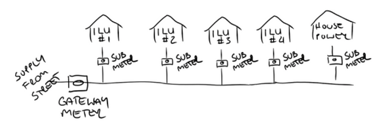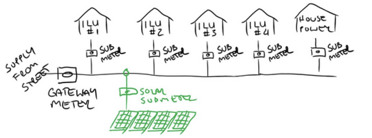An Embedded Network (EN) is effectively a contract between the building owner and an energy retailer to supply electricity to all of the properties in that development. This results in cheaper electricity rates for tenants, additional revenue streams for the developer and, when bundled with solar, generates renewable certificates.
What Happens Now?
Currently, developments are wired with one meter per dwelling, which means every dwelling buys electricity for themselves. This has been the traditional way developments are wired; it's outdated, it's limiting and expensive to builders.
- For apartment owners each meter is negotiated on its own merits and considered small consumers. This means buying electricity above market rate, without bulk buy discounts.
- For builders this means buying meters in advance during construction.
- For developers this means losing multiple potential revenue streams.
What Happens in an EN?
The electrical architecture does not change, we simply add 2 more meters. The 'gateway meter' measures the entire sites consumption, the 'solar submeter' measures the solar energy. The solar reduces the overall electricity supply (usually by 30%) AND generates renewable certificates, which are guaranteed by the Gvt. until 2030.
- The builder no longer has obligation to pre purchase the entire metering for the development, it becomes a seperate financed agreement between the developer and strata: simplifying the electrical scope of works.
- Tenants would access aggregated purchasing discounts (usually 20% below market rate) & incur savings through reduced consumption from solar.
- The EN Owner will generate an ongoing revenue stream from billing for electricity and LGCs.
- The development is more attractive w/ lower rates & green credentials.
Practical Outcomes
Rather than 50 small customers, the Gateway meter looks like one bigger customer to the energy retailer; Origin, ERM, Energy Australia etc.
Instead of buying electricity at retail rates (35c/kWh) the larger EN buys at commercial rates (14c/kWh) or whatever is negotiated. The EN Owner then retails the energy within the network to the residents and can bill for 30c/kWh. The owner of the EN makes a profit and the residents still experience a discount in energy.
For XYZ retirement Village w/ 52 units
Using an average of 15kWh per day = 5,475kWh/pa Current Electricity Price of 35c/kWh = $1,916/pa
EN Aggregate Purchase Price = 18c/kWh EN Owner Service Fee + 10c/kWh
The resident saves 7c/kWh = $380pa saving Each unit will on average generate $550/pa in revenue x 52 units = $30,000 year in revenue to the EN Owner
Future Revenue Additions
Embedded Networks are an exciting way to think about energy as a service, with this type of thinking there are future additional technologies that can generate extra revenue streams.
- Solar Car Ports are a way of adding more solar, improving the experience of a car park & symbolising sustainable thinking.
- Electric Vehicle Charge Points can be added to the EN and charged at a /kWh rate.
- Battery Storage is an exciting addition that could further reduce energy costs.
If you have a development that could benefit from Embedded Networks Smart Commercial Solar have a team of PV Engineers that will answer any of your questions in more detail.







